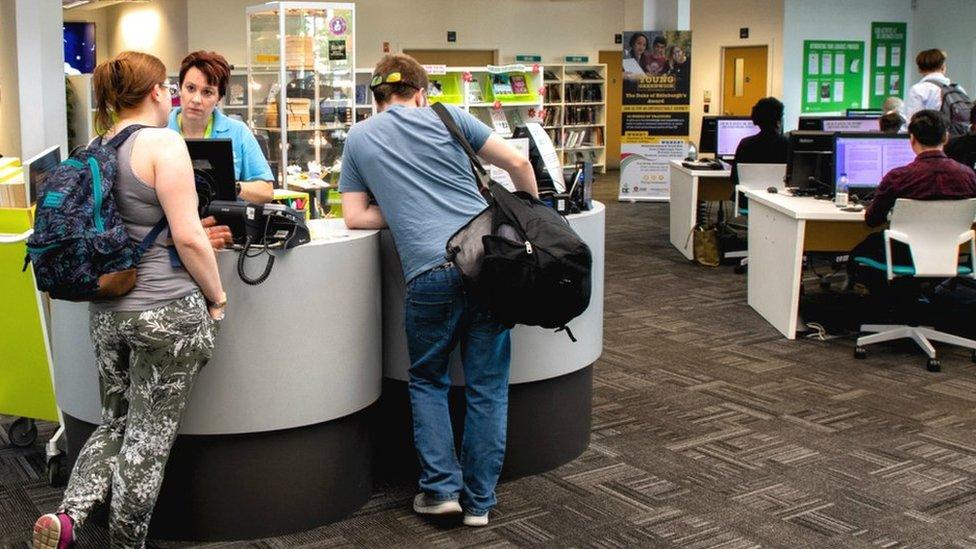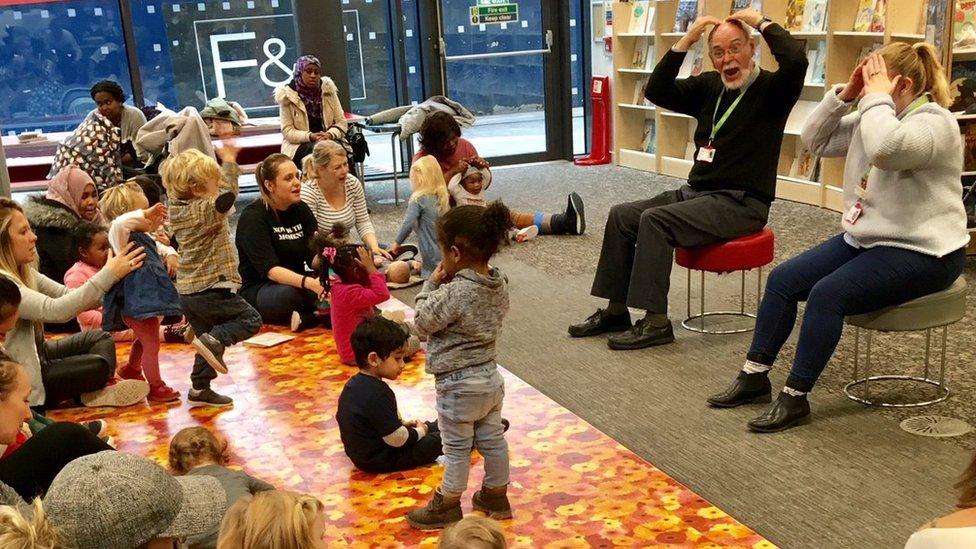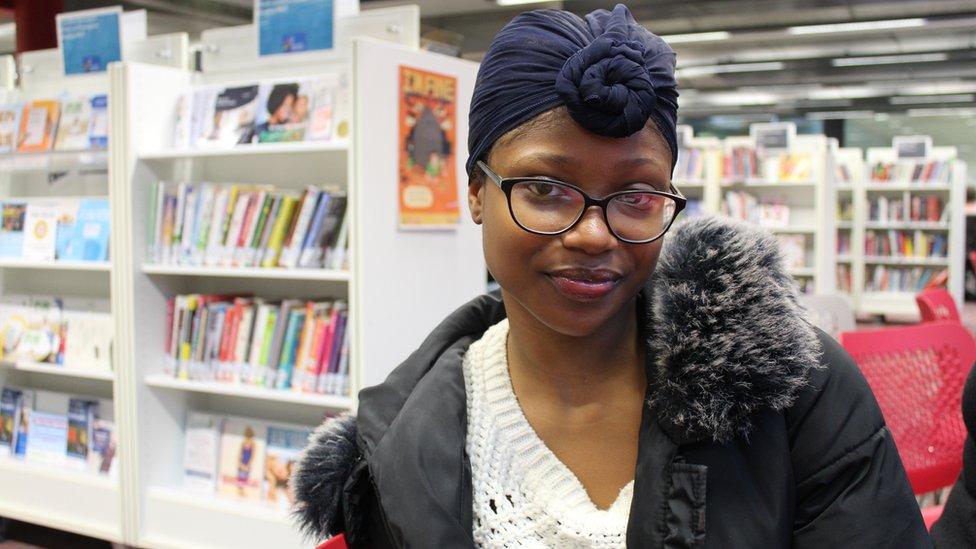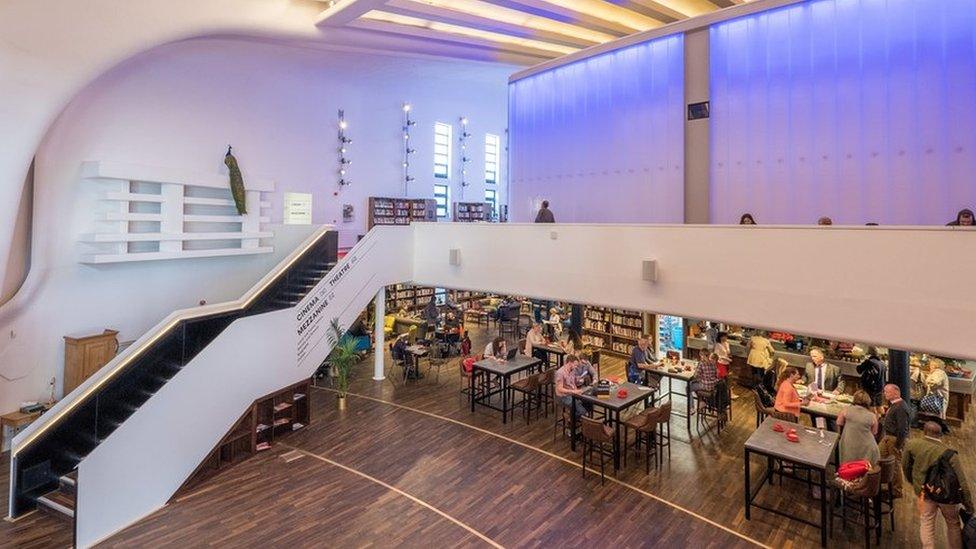Why more people are using these libraries
- Published

Woolwich Centre Library has seen visitor numbers increase since it moved to a new building in 2011
It's Friday evening and Woolwich Centre Library in south-east London is packed.
There are children doing homework, parents chatting, jobseekers using the computers and students making use of the free wi-fi.
The library saw visitor numbers grow to more than 1.2 million last year, bucking the national trend which saw footfall drop by 10 million since 2016/17.
Earlier this month, new figures from the Chartered Institute of Public Finance and Accountancy (Cipfa) - which are based on responses from 81% of councils in England, Wales and Scotland - suggested more than 120 libraries closed last year.
Fola, 42, has been running free tutoring at Woolwich Centre Library since it moved to its current location in 2011.
"This space is fantastic. It's one of the best things that happened to this borough," she says.
Anyone can set up their own community group there for nothing, on top of the busy timetable of activities run by the library ranging from careers workshops to coding lessons.

Woolwich Centre Library has a packed schedule of free activities
While it's clear the building is much more than just a place to borrow books, Fola says having so many groups based there helps boost reading.
"We encourage the children to take books home," she says.
"And when their parents - who might not have read a book since college - come to pick them up, they register and take out books too."
She says the library has also fostered a love of reading for her daughter Anji.
"Books are expensive and here we get them for free!" the 11-year-old says excitedly.

Fola's daughter Anji loves visiting the library
Librarian Richard Davidson agrees attracting visitors for other reasons also boosts reading in the community.
"Book issues have previously been quite low compared to the number of visitors but with the expansion of activities, book loans have also gone up," he says.
A recent study suggested people aged 15-24 were the group most likely to use libraries in England, while the number of young visitors has increased over the past five years.
Tolu, 16, visits twice a week after school to do her homework and revise for exams.
"I can't really study at home because it's too noisy and my family are always asking me to do things," she says.
Fola also points out many people in the area don't have a computer at home. One in 10 UK households still don't have internet access, according to the Office of National Statistics.
One woman, who is unemployed, tells me she visits the library every day to apply for jobs because she can't afford wi-fi or a smartphone.

Tolu studies at the library twice a week
Martin Stone, a sector librarian for GLL, which runs the library on behalf of Greenwich Council, says the secret to its success is simple - an attractive building in a central location, plenty of computers, reliable wi-fi access, and a steady supply of new books.
"The frustrating thing is we know what people want from libraries," says Nick Poole, chief executive of Cilip, the UK's library association.
He argues funding cuts are to blame for falling visitor numbers.
"It's fundamentally about the quality of the offer and that does come back to money," he says.
Local authority spending on libraries fell by £30m in the last year, according to Cipfa.
"Libraries have faced significant cuts under austerity, with councils forced to reduce spending on all 'non-essential' services across the board," the accountancy body's chief executive Rob Whiteman said.
A government spokesman said local authorities were responsible for their own funding decisions and had a statutory duty to provide comprehensive and efficient library services.
He added the government had also invested almost £4m in innovative library projects last year.

Storyhouse in Chester is a former art deco cinema
In Chester, the impact of investing in libraries is clear.
In May 2017, the city's library moved to a new £37m centre called Storyhouse, which also encompasses two theatres, a cinema, cafe and bar.
It was opened with the help of funding from Arts Council England and other sponsors.
Since the move, book loans have increased by 50% and the centre had one million visitors in its first year.
Rachel Foster, the council's library services manager, says the open-plan layout, integration of different facilities and extended opening hours have all helped attract visitors.
Katie Hooper, a 31-year-old teacher from Chester, admits she rarely used the old library but is a regular visitor to Storyhouse.
"It really doesn't feel like a library in the traditional sense," she says.
"It's just got such a nice atmosphere - people aren't tip-toeing around, you can chat, you can sit and have a cup of tea with a book."

At Storyhouse books are spread throughout the building, interspersed with other facilities like a bar and cafe
Rachel says the improvements have been about more than just a shiny new building and a change in approach has helped increase footfall across the borough's 22 libraries.
"We worked with the community to find out what they want from their library," she says.
"Each of our libraries is different and reflects the needs of that community."
For Woolwich librarian Richard, libraries are as important today as ever.
"It's a place people can come and spend all day without spending a penny," he says.
"There isn't anywhere else like that in Woolwich."
- Published29 March 2016

- Published10 April 2017

- Published16 November 2018
